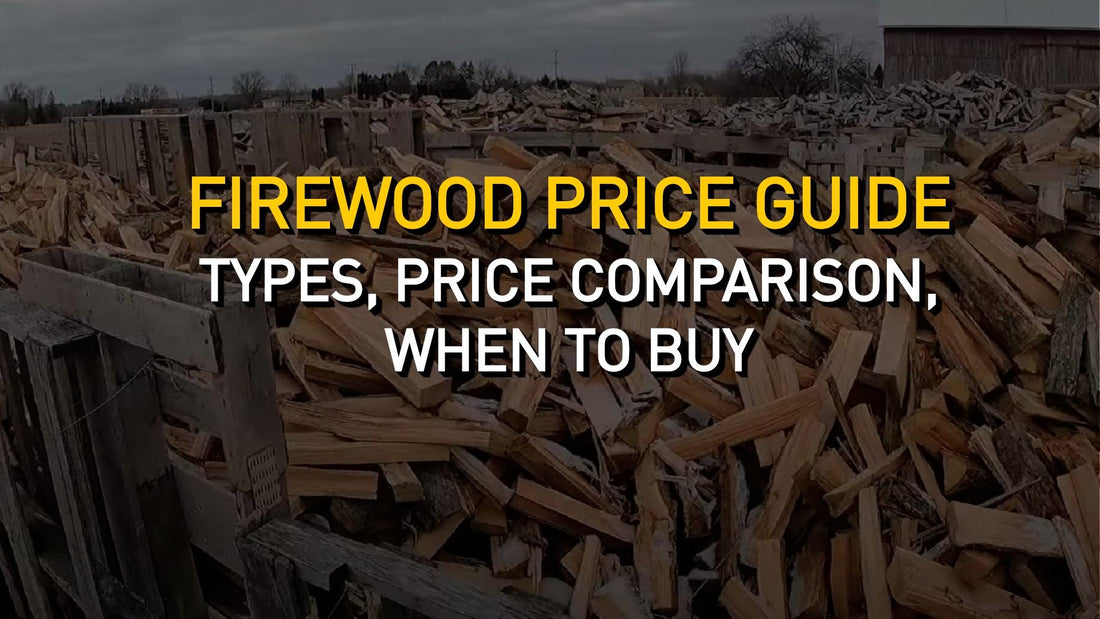
Firewood Price Guide: UK Log Prices, Briquette Prices, Cost Comparison, When to Buy (Updated 2024)
If you’re new to wood heating, purchasing wood logs can be a daunting task. There are dozens of types of firewood logs available for purchase in the UK. Each unique type of firewood has its own unique burn time, heat output profile, moisture content, and—most importantly—price.
In this article, our wood fuel experts will tell you everything you need to know about the different kinds of firewood, the prices you can expect to pay for each of them, and how these prices change over the course of the year.
We’ll also tell you which type of firewood is the cheapest to buy, which provides the best value, which burns the longest, and which provides the most heat. As an added bonus, we’ll also tell you at which time of year you should buy firewood logs if you want to save up to 30% on wood fuel heating.
You May Also Like:
Are Log Burners Worth It? Top Reasons to Get a Wood Burner
Best Supermarket Logs: Asda, ALDI, Tesco, LIDL, Sainsbury's
Why the Top-Down Fire Starting Method Is Best For Wood Stoves
Wood Price Seasonality: When Is the Best Time to Buy Firewood?
The summer is by far the best time to order firewood and briquettes. As most experienced wood fuel users will tell you, the prices of firewood and briquettes fluctuate wildly throughout the year. These regular and predictable changes in supply and demand are referred to as seasonality. Firewood prices are at their lowest during the summer. This is the season when most of it is manufactured and demand is at its lowest. Conversely, wood fuel prices are their absolute highest during the winter when supply is dwindling and demand for heating fuels is at its zenith.
How Does Seasonality Impact Firewood Prices?
While exact figures will vary year by year, customers can expect to pay around 30% less for the same amount of firewood and briquettes in the summer as they would in the winter. There is typically a slight price rise in September, followed by another one in November, and a final price rise as the temperatures plummet in the winter.
This makes summer the perfect time to stock up on wood fuels for the upcoming heating season. If you purchase them in advance, rather than at the last moment, you can potentially save hundreds of pounds.
What Cases the Firewood Price Difference Between Winter and Summer?
Firewood is up to 30% more expensive in the winter due to a wide variety of factors, the main being dwindling supply, spikes in demand, as well as higher storage and delivery costs. Let's take a look at these one by one:
- Dwindling Supply. Firewood is typically cut and dried in the summer months and sold throughout the year. A supplier will typically manufacture as much firewood as they can possibly store in the summer and sell it off during the rest of the year. As the heating season gets into full swing many suppliers find themselves running out of stock to sell.
- Demand Spikes. Once the cold hits, there is typically a sharp spike in demand for firewood, which overwhelms wood supply businesses. Additional staff needs to be brought on (and existing staff needs to be paid overtime) in order to handle the orders and ensure timely delivery.
- High Storage Fees. Firewood needs to be stored in a dry, well-ventilated space, which raises makes it expensive to store. This cost is then passed on to the consumer. When you purchase your firewood in the summer, you only pay for a few weeks or a month worth of storage. When you buy it in the winter, you can be paying for upwards of 6-7 months of storage fees.
- Logistics & Delivery Costs. With everyone wanting firewood in the winter and wanting it quickly, wood fuel manufacturers have to pay their delivery partners a premium for receiving additional delivery bandwidth in the winter. This is especially true of orders made around Christmas where your firewood order needs to compete with millions of presents for space in a delivery van.
Save up to 50% by Buying in Bulk
One of the smartest ways to purchase firewood is in bulk (full pallets). Wood fuel suppliers, including Lekto, will often give you large discounts when you order in bulk. For example, when buying a full pallet of Night Briquettes, you'll pay just half of what you'd normally pay pack (when compared to buying a single pack).
Aren’t All Firewood Logs the Same?
No, there exist numerous types of firewood, with each type having its pros, cons, price points, and ideal use cases. On the UK market today, you can find everything from ultra-budget wet wood to seasoned wood to premium kiln-dried logs. Within each quality level, you’ll find dozens of tree species, from pine and fir at the low end to birch logs, ash logs, and oak logs at the high end. And once you choose the exact kind of firewood you want, you’ll have to settle on a split type and choose a wood fuel supplier you can trust.
For example, While wet pine chunks can cost a fraction of what you’d pay for kiln-dried birch logs, the latter is considered a great value, while the former is something no experienced wood fuel user would even consider burning, even if they were given them for free.
Decoding Firewood Naming Conventions
Understanding what wood to buy may seem daunting, but it gets extremely easy once you understand the principles behind the standard naming convention. It’s very easy to understand and mastering it will instantly make you a lot more knowledgeable about the subject.
Standard Firewood Naming Convention Formula
The standard firewood naming convention consists of three parts: the drying process used, the tree species, and how it was split by the manufacturer. Let’s take “kiln-dried oak logs” as an example:
- Kiln-dried means that they were dried in an industrial kiln, which is the highest quality drying process available.
- Oak refers to the tree species. In this case, it is oak, a premium wood that is prized for its long burn time, high heat output, and high energy density.
- Logs are a generic term used for large pieces of split wood that are judged by the manufacturer to be optimal for day-to-day use.

Diagram highlighting the standard firewood naming convention.
Read also: Wood Heating 101: The Complete Beginner's Guide
Diving Deeper Into the Firewood Naming Process
Now that you understand the naming conventions of wood-fuel firewood logs, let’s delve a little deeper into what these names actually mean. Read this section and you’ll understand more about firewood than 98% of people in the UK.
What Drying Processes Are Used For Firewood?
There are three main types of logs you will encounter on the UK market. Ranked from best to worst, these are kiln-dried firewood, seasoned logs, and unseasoned wood (also known as wet wood or green wood).
- Kiln-Dried Logs. The gold standard of firewood, kiln-dried logs are low in moisture, consistent in quality, produce very little smoke, and are 100% safe to store indoors (even for years at a time). They are created by baking wood in an industrial fanned kiln and typically cost slightly more than seasoned logs. Unless you’re on a very tight budget, this is the type of log to get.
- Seasoned Logs. Coming in at about 10-15% cheaper than kiln-dried logs, seasoned logs can get the job done, but the results are never ideal. The drying process consists of splitting the logs and leaving them outside to air dry. Extra low moisture levels are hard to reach, especially in our climate, and the results will always be uneven as certain logs will hold on to the moisture more than others.
- Wet / Green / Unseasoned Wood. By far the cheapest type of wood on offer. Green wood is freshly chopped wood that has not been subjected to any form of drying. If you want to make your seasoned logs by air-drying them yourself, you can buy wet wood from the local sawmill. In most cases, you’ll need to split the wood yourself, but pre-split wet wood options also exist on the market. This type of wood is not Ready to Burn certified and is illegal for sale in the UK in non-bulk quantities. When sold in bulk, it needs to be sold with in-depth drying instructions.
Read also: What Is Wet Wood & Why Should You Avoid It?
What Are the Best Tree Species to Use For Firewood?
In the context of firewood, trees are typically divided into hardwoods (e.g. oak, birch, and ash) and softwoods (e.g. pine or fit). Hardwood trees are universally better for use as logs, since they burn cleaner, longer, and at a higher temperature. Softwood logs are not recommended, since they burn out quickly and contain sap, which makes the wood smoke and smoulder. This being said, softwood trees are super easy to light and release their heat quickly, which makes them perfect for making premium wood kindling.
Read also: Wood Heating Showdown: Softwood Logs vs Hardwood Logs
What Is the Optimal Split Type For Firewood?
Logs are by far the most convenient wood split type to use for firewood. The definition of a log varies from sawmill to sawmill, but they need to be large enough to burn for a long time, yet small enough for easy handling. Other types of splits include kindling, which is a word used to refer to small pieces of wood that are used to start fires. Another type you may encounter is the word chunk, which refers to small scraps from the sawmilling process, which can be bought cheap but aren’t worth using in log burners. Sawdust is also technically a split type, but you would only buy it for heating in the form of already-compressed wood briquettes.
What Is the Cheapest Type of Firewood to Buy in the UK?
The cheapest type of firewood available for purchase in the UK today is unseasoned poplar and willow wood. It can be bought from a vendor like The Parks Trust for as little as £210 per 5 tonnes. This being said, what you’re getting are cut-down, branch-free trees that you’ll need to cut to size, split into logs, and air dry yourself for a period of between 6 and 24 months, depending on the climate in your region.
What Firewood Offers the Best Value in the UK?
If what you’re after is fuss-free Ready to Burn firewood that arrives at your doorstep in a convenient, easy-to-handle box, we recommend Kiln-Dried Birch Logs. They offer ultra-high quality at a lower price than what you’d pay for ash or oak logs.
What Is a Good Price For Firewood in the UK?
Firewood prices vary from region to region and depending on the type of wood you’re buying. Seasonality is also an important factor. Wood fuel prices are at their highest during the winter heating season and are at their lowest during the summer. Here is a list of fair prices for a pallet of premium kiln-dried logs (if purchased in the summer):
- Premium Kiln-Dried Birch Logs: Aim to purchase them for well under £450, including free UK-wide delivery to your doorstep.
- Premium Kiln-Dried Oak Logs: These can be purchased for well under £500 during the summer months, including free UK-wide delivery to your doorstep.
This article was updated on January 19, 2024.

